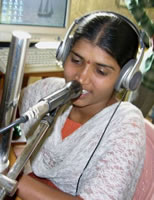Launch of Research publication and CD-ROM on editorial independence and the media at Asian Media Information and Communication Centre, Singapore
22-08-2006 (New Delhi)

India - female broadcaster
Asia has witnessed a profound transformation of its media landscape since the mid-1980s when deregulation of state television monopolies resulted in a dramatic growth in commercial television outlets.
Cable and satellite television have since proliferated at a phenomenal rate providing Asians with a wide range of television channels. In this commercial environment, it is imperative to find ways in which the media can remain accountable and transparent and continue to promote and protect the public interest. This is why, more than ever before, public service television should be strengthened to ensure that freedom of thought and expression, pluralism and accountability are protected.
To assess progress made in this area since the dawn of broadcast liberalization in Asia, within the framework of IPDC project entitled, "Promoting Editorial Independence and media pluralism", (PDC/23 RAS/03) implemented by the Asian Media Information and Communication Centre, (AMIC) Singapore, country specific research was carried out in eight South and Southeast Asia states, namely, Bangladesh, India, Indonesia, Malaysia, Pakistan, Philippines, Sri Lanka and Thailand. The main objective was to assess the editorial independence of public service broadcasting (PSB) television in these countries and to sensitize media and advocacy groups on media freedom.
The resulting publication addresses aspects of editorial independence and programming diversity and focuses on the varying degrees of :
(i) freedom of expression on television in the countries concerned vis-à-vis government regulations;
(ii) ‘objectivity’ in reporting news and events (and how political or financial constraints may hinder this);
(iii) visibility of public good;
(iv) the practice of pluralism both in human resources as well as content.
Based on qualitative research methodology, the major solution envisaged remains concentrated and targeted advocacy and awareness-raising among media and advocacy groups, concerned government authorities, parliamentarians and others who influence public opinion.
A CD-ROM package of all 8 country reports is now available, together with recommendations, links to relevant websites and interesting articles from different countries dealing with this topic. This is soon to be available on the AMIC website.
The CD-ROM, launched at the 15th Annual Conference of AMIC in Penang, Malaysia last July, is expected to be a valuable resource for PSB institutions, television trainers, civil society groups dealing with media freedom and cultural diversity issues, and tertiary institutions as a “classroom” and advocacy resource.
To assess progress made in this area since the dawn of broadcast liberalization in Asia, within the framework of IPDC project entitled, "Promoting Editorial Independence and media pluralism", (PDC/23 RAS/03) implemented by the Asian Media Information and Communication Centre, (AMIC) Singapore, country specific research was carried out in eight South and Southeast Asia states, namely, Bangladesh, India, Indonesia, Malaysia, Pakistan, Philippines, Sri Lanka and Thailand. The main objective was to assess the editorial independence of public service broadcasting (PSB) television in these countries and to sensitize media and advocacy groups on media freedom.
The resulting publication addresses aspects of editorial independence and programming diversity and focuses on the varying degrees of :
(i) freedom of expression on television in the countries concerned vis-à-vis government regulations;
(ii) ‘objectivity’ in reporting news and events (and how political or financial constraints may hinder this);
(iii) visibility of public good;
(iv) the practice of pluralism both in human resources as well as content.
Based on qualitative research methodology, the major solution envisaged remains concentrated and targeted advocacy and awareness-raising among media and advocacy groups, concerned government authorities, parliamentarians and others who influence public opinion.
A CD-ROM package of all 8 country reports is now available, together with recommendations, links to relevant websites and interesting articles from different countries dealing with this topic. This is soon to be available on the AMIC website.
The CD-ROM, launched at the 15th Annual Conference of AMIC in Penang, Malaysia last July, is expected to be a valuable resource for PSB institutions, television trainers, civil society groups dealing with media freedom and cultural diversity issues, and tertiary institutions as a “classroom” and advocacy resource.
Related themes/countries
· Bangladesh
· Indonesia
· Malaysia
· Pakistan
· Philippines
· Sri Lanka
· Thailand
· India: News Archive 2006
· Public Service Broadcasting: News Archives 2006
Share this story:
Contact information
-
Contact
- Jocelyne Josiah, UNESCO Office in New Delhi
- Asian Media Information and Communication Centre (AMIC)
- UNESCO
Source














